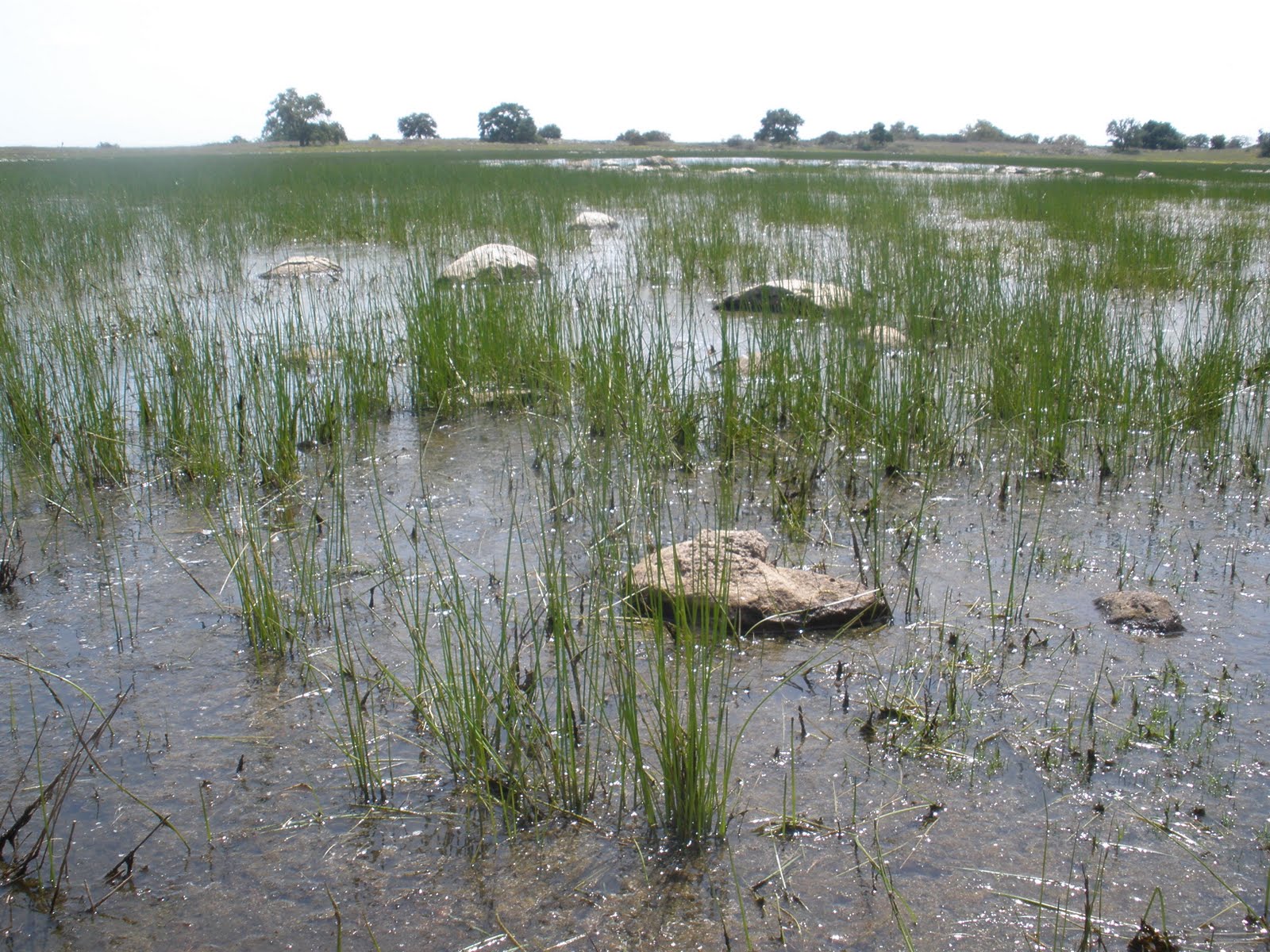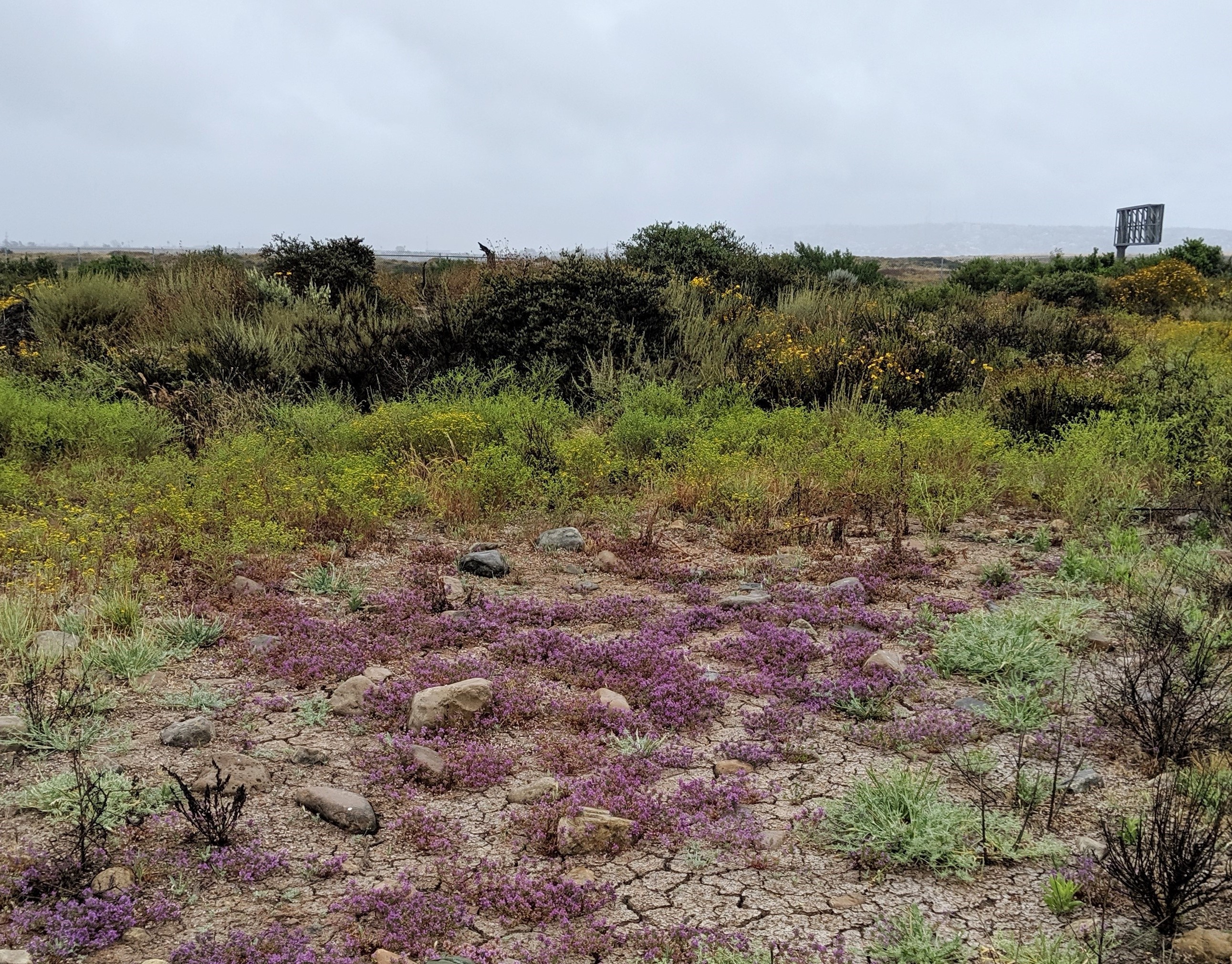|
California Least Tern Predator Monitoring (Ternwatchers)
Volunteer-based predator monitoring program at the nesting sites in Mission Bay. Citizen scientists are trained to monitor nesting sites for predators from mid-April through late May, with the program concluding the end of September.
|
|
Dennery Canyon Rare Plant Restoration
The goal of this project is to restore and enhance populations of four Management Strategic Plan (MSP) plant species and vernal pool habitat over a three-year period. Species directly benefiting from this effort include: San Diego thornmint (Acanthomintha ilicifolia), Otay tarplant (Deinandra conjugens), San Diego ambrosia (Ambrosia pumila), Orcutt's bird's beak (Dicranostegia orcuttiana). The proposed project area encompasses approximately 8.68 acres. It provides a unique setting where the fours species co-exist with vernal pools not previously documented in the Vernal Pool Habitat Conservation Plan (VPHCP). Annual inspect and manage (IMG) monitoring results indicate increasing threats (primarily non-native weeds) are impacting MSP species populations in this area, and an intensive restoration effort is needed to ensure the long-term persistence of these species. Activities will consist of weed management, seed collection, seed bulking and redistribution, trash removal, vegetation monitoring, photo monitoring, and IMG monitoring. The proposed project will utilize the most current state of management knowledge along with Best Management Practices (BMPs) that have been successfully implemented in the region. This project is consistent with management objectives and actions in the MSP Roadmap, the MSP Framework Rare Plant Management Plan, and the MSP Seed Collection, Banking, and Bulking Plan. This project is partially funded by SANDAG TransNet EMP Land Management Grant #S1125503.
|
|
Furby-North Preserve Unauthorized Control Project
Currently there are multiple unauthorized trails on the Property. The Property is surrounded on all sides by heavy urbanization, and local residents frequently hike through using the northern access road or unauthorized trails. Off-road vehicle use, specifically motorcycles, is also a problem within the Property. Failure to control access to the unauthorized trails on the Property will cause further loss of on-site sensitive vegetation communities including maritime succulent scrub, Diego coastal sage scrub and vernal pools. In addition, special status species observed on-site including the coastal California gnatcatcher and coastal cactus wren could be affected by unauthorized use of the Property. This one-year project will add signage, fencing, and gates on the Property to prevent unauthorized access into and across the Property and allow for future active restoration of the unauthorized trails as outlined in the Resource Management Plan. The County will coordinate with the SANDAG enforcement program to increase patrols and enforce County regulations on the Property once signs are intellect, The County also will coordinate with Earth Discovery Institute to develop a public outreach program with the San Ysidro School District,including, but not limited to, the distribution of flyers discussing general ecology using the proposed project as an example of how good stewardship results in positive biological changes The message will encourage school children to participate in the conservation effort of their local flora and fauna and thus reduce trespassing across the Property. The County will provide on-site monitoring during installation and post-installation of fencing, gates, and signs to document the effectiveness.
|
|
Human impact to vernal pool complexes in Southern California
The flagship species for San Diego County's vernal pools is the federally endangered San Diego fairy shrimp (Branchinecta sandiegonensis: SDFS). For this species, the most critical
management issues are likely to involve population connectivity. Degradation of the landscape, direct damage (often by vehicles), creation of new basins (most often road ruts) and increasing biotic connectivity (beyond historic levels) are also important factors. The specific goals of this study were focused in three areas: landscape genetics in the San Diego fairy shrimp B. sandiegonensis; hybridization between B. sandiegonensis and B. lindahli; and conservation, management and recovery of B. sandiegonensis. This was a project jointly funded by SANDAG and a CDFW Section 6 grant.
|
|
J26 Vernal Pool Monitoring- Vista Del Mar Elementary School Project
Five-year monitoring of vernal pool reference site J26 Vernal Pool Complex as part of the comprehensive mitigation program associated with the construction of the San Ysidro School District's Vista Del Mar Elementary School. The J26 Complex is formally recognized by the USFWS as a vernal pool reference site. It is located 10 km north of the restoration area. Vernal pools in the J26 Complex were chosen as control pools to monitor restoration success. This includes monitoring of San Diego fairy shrimp populations, vernal pool plant germination and abundance, and levels of inundation in a healthy vernal pool system.
|
|
Otay Mesa Rare Plants
The Otay Mesa Rare Plants Project will improve the conservation status of several of San Diego County's rarest plants on important conserved lands in Otay Mesa. The Project includes seed bulking for two high-priority Management Strategic Plan (MSP) plant species and direct restoration of five MSP plants with seeding, planting, and maintenance. Seeding, planting, and maintenance for the MSP plants will be conducted as part of two separate habitat restoration projects, one to restore vernal pools and maritime succulent scrub and another to restore maritime succulent scrub and native grasslands. This project was partially funded by SANDAG TransNet EMP Land Management Grant #5004954.
|
|
Otay Mesa Vernal Pool Restoration
The primary goal is to expand on previous grant projects to protect, and enhance vernal pool ecosystems, maritime succulent scrub (MSS) and Western burrowing owl habitats in the Goat Mesa and Wruck Canyon vernal pool complexes to create a buffer from invasive weed species and reduce sediment erosion. The main objectives to reach these goals are 1) perform brush/thatch removal and weed control within enhancement areas, 2) collect and broadcast vernal pool species seed within pools and install MSS habitat plants and seed in the upland enhancement areas and 3) install fence around Wruck Canyon vernal pools to protect them from illegal off-road activity. Contracted crews will be hired to perform brush/weed control, herbicide application and be used to collect, grow and bulk vernal pool species seed from nearby pools to seed the vernal pools and install MSS container plants/cuttings/seeds in the habitat enhancement areas.
Contracted crews will also be used to install fence, erosion control materials and perform access road repairs as needed to safely access the areas. Container plants, seeds, plant protectors, fence materials and erosion control materials will be purchased directly by City staff or supplied by the contractors. City staff will perform project management.
This project was fully funded by SANDAG TransNet EMP Land Management Grant #S1125467
|
|
Proctor Valley Vernal Pools and Uplands Habitat Restoration Project
The Proctor Valley Vernal Pool and Uplands Habitat Restoration Project will complete restoration of 19 acres of vernal pools and coastal sage scrub in Proctor Valley on the City of San Diego's Otay Lakes Cornerstone Lands, a biological core area under the San Diego MSCP. The Project includes restoration of vernal pools and coastal sage scrub habitat and establishment of occurrences of two high-priority Management Strategic Plan (MSP) plants with seed collection, seed bulking, propagation, planting and seeding, and maintenance. The Project also includes restoration of habitat specific to the needs of several MSP animal species through seeding and planting of host and nest plants, construction of artificial burrows, and other measures.
Project partially funded by SANDAG TransNet EMP Land Management Grant #5001972 and #5004955.
|
|
Regional Grazing Monitoring Plan
This project evaluates using grazing as a management tool for degraded grasslands and coastal sage scrub habitat. Pilot projects will be conducted to look at the efficacy of grazing as management tool and necessary monitoring methods. The project was designed to answer four primary questions (and their associated objectives): 1) How effective is grazing at reducing fire risk? 2) Can grazing effectively enhance disturbed native grassland and forb habitats 3) Can grazing enhance disturbed native coastal sage scrub habitat? 4) Can grazing reduce nonnative grass and forb cover in disturbed coastal sage scrub to increase native shrub cover and bare ground and improve habitat for MSP species such as Quino checkerspot butterfly (Euphydryas editha quino), California gnatcatcher (Polioptila californica), black-tailed jackrabbit (Lepus californicus), burrowing owl (Athene cunicularia hypugaea), and Stephen' kanagroo rat (Dipodomys stephensi)? Initial study sites were established at Rancho Jamul Ecological Reserve and Hollenbeck Canyon Wildlife Area, and the project has recently expanded to Ramona. This is a SANDAG-funded project.
|
|
Shinohara Vernal Pool Restoration
In 2007 the San Diego National Wildlife Refuge began work to restore approximately 30 acres of vernal pool habitat on the former Shinohara parcel. The overall goal of the vernal pool restoration project was to establish healthy vernal pool habitat and associated coastal sage scrub/native grassland where vernal pool and other native flora and fauna are likely to persist. In April 2007, the restoration site was dethatched and more than 60 degraded vernal pool basins were deepened. Weed control was conducted annually in the growing seasons of 2007/2008, 2008/2009, and 2009/2010. One herbicide treatment was completed late in the 2011/2012 growing season. Where native flora was present in vernal pool basins, the basins were hand-weeded; otherwise, weeds were controlled with glyphosate herbicide. The restoration project included a combination of detatching, topographic re-contouring of basins, weed control, planting, and monitoring. In September 2007, 10 underground nest boxes for burrowing owls (Athene cunicularia) were installed on the site. Starting in 2009, the number of owls on site gradually declined, and they have not been known to breed there since 2011. Decline in breeding is attributed to the development of the sage scrub habitat on the site.
|
|
Spring Canyon/Goat Mesa Vernal Pool Restoration
The vernal pools at the Spring Canyon/Goat Mesa complex (J16-J18) and surrounding open space have suffered considerable off-road damage over the years. This damage has resulted in changes in hydrologic, flow patterns, and inundation characteristics. This vernal pools complex was identified by the adopted Recovery Plan for Vernal Pools of Southern California (USFWS 1998) as necessary to stabilize populations of the following endangered and threatened MSP species: E. aristulatum, P. nudiuscula, N. fossalis, O. californica, B. sandiegonensis, and S. wootoni. The Management Strategic Plan (MSP) for Conserved Lands in Western San Diego County (SDMMP) also lists other MSP species historically found onsite, including D. variegata, M. minimus, S. hammondii, and A cunicularia. Minimization of illegal off-road vehicle use is the primary goal. The main objective to reach the goal is to use to fence off as many of the key access points and areas of frequent off-road vehicle use throughout the City open space to protect the habitat for the endangered and threatened species that exist onsite. This will be done by hiring a fence contractor to provide all supplies and install the fence. This project was partially funded by SANDAG TransNet EMP Land Management Grant #5004945 .
|
|
Vegetation Mapping 2025
The goal of this project is to create a new vegetation map for the western portion of San Diego County. This will be based on the Vegetation Classification Manual hierarchical classification system. The map will consist of a group-level comprehensive map based on satellite remote sensing and an alliance/association map focused on existing preserves or important resources.
|
|
Vegetation Mapping and Classification 2012
This project first created a vegetation classification system and manual. Then, based on 2012 data, this project completed 3 tasks: Task 1. Vegetation Mapping. Task 2. Invasive Nonnative Species Plant Mapping. Task 3. Tecate Cypress Mapping. In 2014, the data was updated based on user's comments. The final products are available to download in the data section.
|

